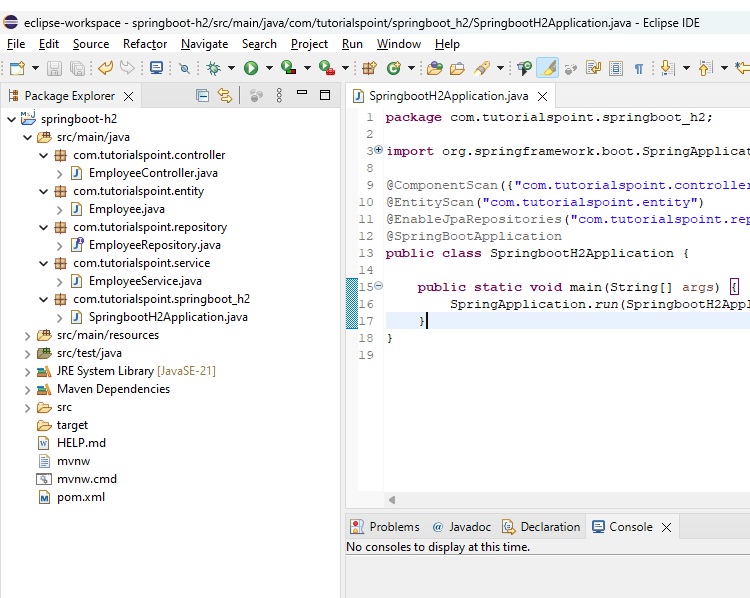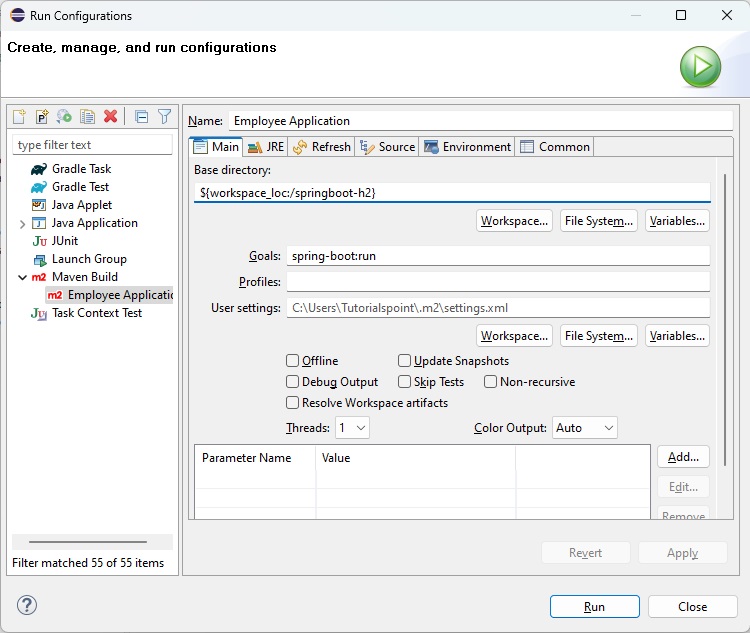
- Spring Boot & H2 - Home
- Spring Boot & H2 - Overview
- Spring Boot & H2 - Environment Setup
- Spring Boot & H2 - Project Setup
- Spring Boot & H2 - REST APIs
- Spring Boot & H2 - H2 Console
Spring Boot & H2 Examples
- Spring Boot & H2 - Add Record
- Spring Boot & H2 - Get Record
- Spring Boot & H2 - Get All Records
- Spring Boot & H2 - Update Record
- Spring Boot & H2 - Delete Record
- Spring Boot & H2 - Unit Test Controller
- Spring Boot & H2 - Unit Test Service
- Spring Boot & H2 - Unit Test Repository
Spring Boot & H2 Useful Resources
Spring Boot & H2 - Project Setup
As in previous chapter Environment Setup, we've imported the generated spring boot project in eclipse. Now let's create the following structure in src/main/java folder.

com.tutorialspoint.controller.EmployeeController − A REST Based Controller to implement REST based APIs.
com.tutorialspoint.entity.Employee − An entity class representing the corresponding table in database.
com.tutorialspoint.repository.EmployeeRepository − A Repository Interface to implement the CRUD operations on the database.
com.tutorialspoint.service.EmployeeService − A Service Class to implement the business opearations over repository functions.
com.tutorialspoint.springboot_h2.SprintBootH2Application − A Spring Boot Application class.
SprintBootH2Application class is already present. We need to create the above packages and relevant classes and interface as shown below −
Entity - Entity.java
Following is the default code of Employee. It represents a Employee table with id, name, age and email columns.
package com.tutorialspoint.entity;
import jakarta.persistence.Column;
import jakarta.persistence.Entity;
import jakarta.persistence.Id;
import jakarta.persistence.Table;
@Entity
@Table
public class Employee {
// database column mappings
@Id
@Column
private int id;
@Column
private String name;
@Column
private int age;
@Column
private String email;
// setter/getter methods
public int getId() {
return id;
}
public void setId(int id) {
this.id = id;
}
public String getName() {
return name;
}
public void setName(String name) {
this.name = name;
}
public int getAge() {
return age;
}
public void setAge(int age) {
this.age = age;
}
public String getEmail() {
return email;
}
public void setEmail(String email) {
this.email = email;
}
}
Repository - EmployeeRepository.java
Following is the default code of Repository to implement CRUD operations on above entity, Employee.
package com.tutorialspoint.repository;
import org.springframework.data.repository.CrudRepository;
import org.springframework.stereotype.Repository;
import com.tutorialspoint.entity.Employee;
@Repository
public interface EmployeeRepository extends CrudRepository<Employee, Integer> {
}
Service - EmployeeService.java
Following is the default code of Service to implement operations over repository functions.
package com.tutorialspoint.service;
import java.util.List;
import org.springframework.beans.factory.annotation.Autowired;
import org.springframework.stereotype.Service;
import com.tutorialspoint.entity.Employee;
import com.tutorialspoint.repository.EmployeeRepository;
@Service
public class EmployeeService {
@Autowired
EmployeeRepository repository;
// to be implemented
public Employee getEmployeeById(int id) {
return null;
}
// to be implemented
public List<Employee> getAllEmployees(){
return null;
}
// to be implemented
public void saveOrUpdate(Employee employee) {
}
// to be implemented
public void deleteEmployeeById(int id) {
}
}
Controller - EmployeeController.java
Following is the default code of Controller to implement REST APIs.
package com.tutorialspoint.controller;
import java.util.List;
import org.springframework.beans.factory.annotation.Autowired;
import org.springframework.web.bind.annotation.DeleteMapping;
import org.springframework.web.bind.annotation.GetMapping;
import org.springframework.web.bind.annotation.PathVariable;
import org.springframework.web.bind.annotation.PostMapping;
import org.springframework.web.bind.annotation.PutMapping;
import org.springframework.web.bind.annotation.RequestBody;
import org.springframework.web.bind.annotation.RequestMapping;
import org.springframework.web.bind.annotation.RestController;
import com.tutorialspoint.entity.Employee;
import com.tutorialspoint.service.EmployeeService;
@RestController
@RequestMapping(path = "/emp")
public class EmployeeController {
@Autowired
EmployeeService employeeService;
// to be implemented
@GetMapping("/employees")
public List<Employee> getAllEmployees(){
return null;
}
// to be implemented
@GetMapping("/employee/{id}")
public Employee getEmployee(@PathVariable("id") int id) {
return null;
}
// to be implemented
@DeleteMapping("/employee/{id}")
public void deleteEmployee(@PathVariable("id") int id) {
}
// to be implemented
@PostMapping("/employee")
public void addEmployee(@RequestBody Employee employee) {
}
// to be implemented
@PutMapping("/employee")
public void updateEmployee(@RequestBody Employee employee) {
}
}
Application - SprintBootH2Application.java
Following is the updated code of Application to use above classes.
package com.tutorialspoint.springboot_h2;
import org.springframework.boot.SpringApplication;
import org.springframework.boot.autoconfigure.SpringBootApplication;
import org.springframework.boot.autoconfigure.domain.EntityScan;
import org.springframework.context.annotation.ComponentScan;
import org.springframework.data.jpa.repository.config.EnableJpaRepositories;
@ComponentScan({"com.tutorialspoint.controller","com.tutorialspoint.service"})
@EntityScan("com.tutorialspoint.entity")
@EnableJpaRepositories("com.tutorialspoint.repository")
@SpringBootApplication
public class SpringbootH2Application {
public static void main(String[] args) {
SpringApplication.run(SpringbootH2Application.class, args);
}
}
Run/Debug Configuration
Create following maven configuration in eclipse to run the springboot application with goal spring-boot:run. This configuration will help to run the REST APIs and we can test them using POSTMAN.
